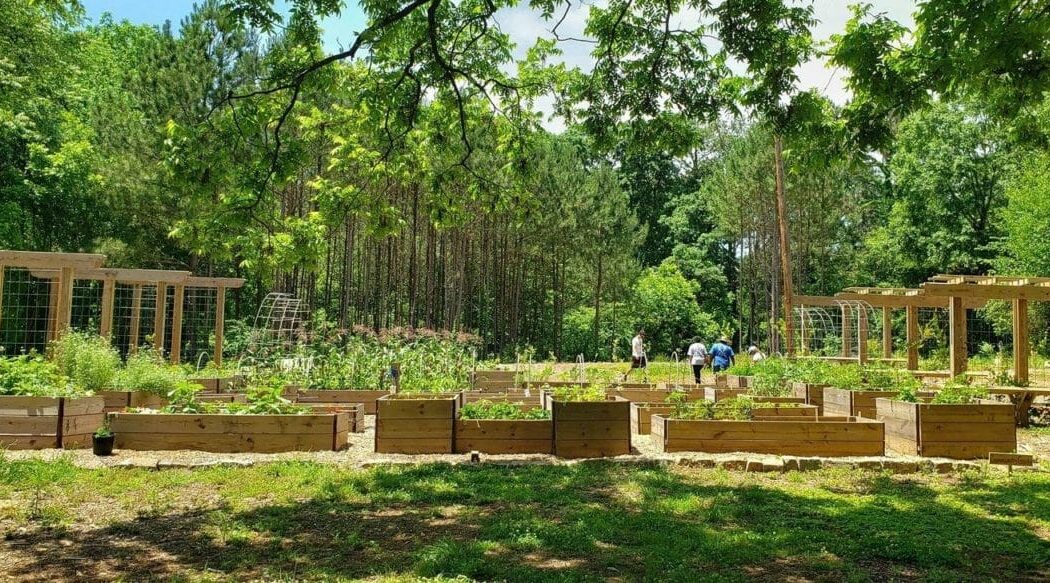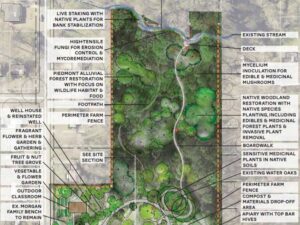In the Browns Mill neighborhood of Atlanta, Georgia, The Conservation Fund, the City of Atlanta Office of Resilience and Department of Parks & Recreation, along with Trees Atlanta, are partnering with community residents to create a new kind of public park—a park you can eat.
Atlanta’s first Food Forest is just getting growing, but the seven acres is already providing fresh fruits, nuts, and vegetables. It joins some 70 others nationwide, and will likely be the largest of them.
Besides being Atlanta’s first Community Urban Food Forest, it serves as a new model for the city’s parks. The food forest will produce a wide variety of fresh, flavorful, and healthy nuts, fruits, vegetables, herbs, and mushrooms, which will become available for public consumption.
Located in an area identified as a food desert, the site was a working farm as recently as 2000. Neighbors still talk about the land’s former owners, Ruby and Willie Morgan, who left excess produce from their farm on fence posts for neighbors to claim and enjoy.
A COMPREHENSIVE APPROACH TO CONSERVATION
The Food Forest approaches conservation through the concept of Agriforestry: using agriculture that integrates trees and shrubs with food production to create healthy and ecologically resilient landscapes.
That means using native trees and plants that produce nutritious foods, but that also provide resources to local wildlife and pollinator species, capture stormwater and mitigate flooding, filter air and water, and create a more sustainable urban landscape.
WHY THIS PROJECT MATTERS
Abandoned and neglected for many years, the farm’s history is still visible with several large pecan trees, blackberry brambles, and muscadine vines that now grow wild across the land.
Working with residents and a variety of stakeholders, the Fund has helped steward the creation of a community-driven concept plan that includes community garden beds, a fruit and nut orchard, herb gardens, walking trails, and gathering spaces.
Partners and residents are currently working together to implement the community vision plan and bring new food resources to this community in need of fresh and healthy foods.
The Urban Food Forest at Browns Mill is currently the largest public food forest in the country and serves as a model for integrating food resources into equitable park development plans, in order to provide long-term benefits for local communities.
COMMUNITY BENEFITS
- Vacant and neglected land is being transformed into a community asset that provides a safe place for kids to play and families to gather;
- Community members have increased access to fresh, nutritious food, with 30 new community garden beds already built and more than 100 fruit trees planted so far;
- Educational programs, including gardening and cooking classes are encouraging physical activity and healthy eating;
- Residents have participated in paid workforce training opportunities and several are currently employed at the Food Forest;
- Residents, students, and corporate partners have committed countless volunteer hours to the project with more than 1000 volunteers to date and ongoing opportunities for participation;
- Partnerships with area schools have already brought hundreds of students to the Food Forest for STEM-based, outdoor learning and environmental education;
- Native plants, area wildlife, tree canopy, and an onsite stream are now protected. Invasive species are being removed and native plants restored to the forest and streambank; and
- Walking trails now provide opportunities for exercise and recreational activities, like birdwatching and foraging.
Growing a Food Forest with Perennials
When you hear the terms “perennials” and “annuals”, do you think of garden flowers? Most of us do. By definition, annuals are plants that live for one season or a year, biennials live for 2 years, and perennials live for 3 or more years. Do you know what else are perennials? Trees! Along with shrubs, many vines, and most herbs and vegetables (a few good examples in each category are blueberry shrubs, muscadine vines, mountain mint, and wild ramps).
Perennial trees produce flowers that are ecologically crucial and aesthetically stunning for decades. Most trees will bloom hundreds or thousands of flowers each year, practically an entire wildflower meadow’s worth of blossoms. One notable blooming tree genus is Quercus or oaks, which support over 500 species including moths and butterflies. Many trees also bear fruit and nuts, including some of our native trees that humans love such as pawpaw, Chickasaw plum, serviceberry, and pecan.
Different categories of plants and trees can be visualized as layers in the forest. Canopy trees, lower trees, shrubs, herbs/vegetables, roots, mushrooms, and vines make up the seven layers of a perennial food forest system. A food forest, also called a forest garden, is a diverse planting of edible plants that attempts to mimic the ecosystems and patterns found in nature.
Native perennial flowers also provide “free food” the area’s native bee populations, increasing the pollination rates for fruit and berry trees/shrubs. They also feed beneficial predators such as wasps, which perform natural pest control in your vegetable garden.
The Urban Food Forest at Browns Mill is an excellent example of how the seven layers of a food forest work in harmony to produce food (and medicine!) year after year thanks to perennials.
ADDITIONAL COMMUNITY PARTNERS
- City of Atlanta
- City of Atlanta Parks and Recreation
- Trees Atlanta
- Aglanta
- US Forest Service
- National Park Service
- Greening Youth Foundation
- Concrete Jungle
- Food Well Alliance
- Fruit Forward
- Friends of the Urban Food Forest at Browns Mill
- Park Pride
- West Atlanta Watershed Alliance
- Atlanta Audubon
- EarthShare of Georgia
- Georgia Forestry Commission
- The Mary Alice and Bennett Brown Foundation
- The Turner Foundation
- National Fish and Wildlife Foundation
- American Family Insurance
- Sustenance Design and STAND Landscape Architects
Featured photo courtesy of Shannon Lee, the Conservation Fund.


